The NVIDIA GeForce GTX 980 Ti Review
by Ryan Smith on May 31, 2015 6:00 PM ESTCompute
Shifting gears, we have our look at compute performance. Since GTX Titan X has no compute feature advantage - no fast double precision support like what's found in the Kepler generation Titans - the performance difference between the GTX Titan X and GTX 980 Ti should be very straightforward.
Starting us off for our look at compute is LuxMark3.0, the latest version of the official benchmark of LuxRender 2.0. LuxRender’s GPU-accelerated rendering mode is an OpenCL based ray tracer that forms a part of the larger LuxRender suite. Ray tracing has become a stronghold for GPUs in recent years as ray tracing maps well to GPU pipelines, allowing artists to render scenes much more quickly than with CPUs alone.
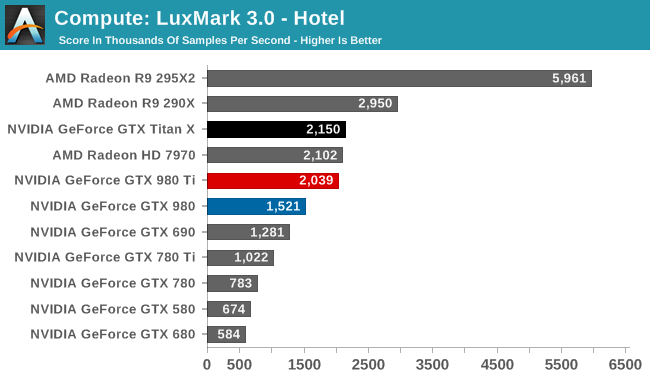
With the pace set for GM200 by GTX Titan X, there’s little to say here that hasn’t already been said. Maxwell does not fare well in LuxMark, and while GTX 980 Ti continues to stick very close to GTX Titan X, it none the less ends up right behind the Radeon HD 7970 in this benchmark.
For our second set of compute benchmarks we have CompuBench 1.5, the successor to CLBenchmark. CompuBench offers a wide array of different practical compute workloads, and we’ve decided to focus on face detection, optical flow modeling, and particle simulations.
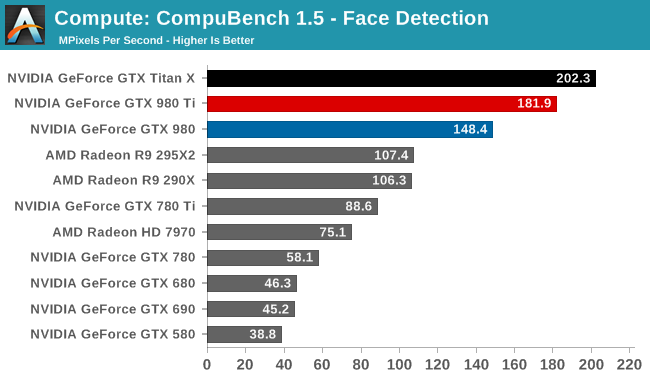
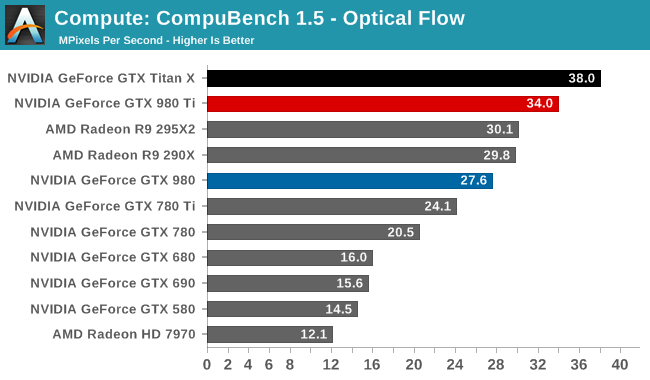
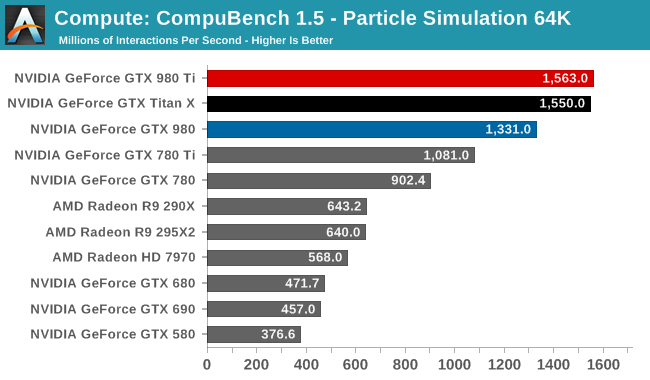
Although GTX T980 Ti struggled at LuxMark, the same cannot be said for CompuBench. Though taking the second spot in all 3 sub-tests - right behind GTX Titan X - there's a bit wider of a gap than normal between the two GM200 cards, causing GTX 980 Ti to trail a little more significantly than in other tests. Given the short nature of these tests, GTX 980 Ti doesn't get to enjoy its usual clockspeed advantage, making this one of the only benchmarks where the theoretical 9% performance difference between the cards becomes a reality.
Our 3rd compute benchmark is Sony Vegas Pro 13, an OpenGL and OpenCL video editing and authoring package. Vegas can use GPUs in a few different ways, the primary uses being to accelerate the video effects and compositing process itself, and in the video encoding step. With video encoding being increasingly offloaded to dedicated DSPs these days we’re focusing on the editing and compositing process, rendering to a low CPU overhead format (XDCAM EX). This specific test comes from Sony, and measures how long it takes to render a video.

Traditionally a benchmark that favors AMD, GTX 980 Ti fares as well as GTX Titan X, closing the gap some. But it's still not enough to surpass Radeon HD 7970, let alone Radeon R9 290X.
Moving on, our 4th compute benchmark is FAHBench, the official Folding @ Home benchmark. Folding @ Home is the popular Stanford-backed research and distributed computing initiative that has work distributed to millions of volunteer computers over the internet, each of which is responsible for a tiny slice of a protein folding simulation. FAHBench can test both single precision and double precision floating point performance, with single precision being the most useful metric for most consumer cards due to their low double precision performance. Each precision has two modes, explicit and implicit, the difference being whether water atoms are included in the simulation, which adds quite a bit of work and overhead. This is another OpenCL test, utilizing the OpenCL path for FAHCore 17.
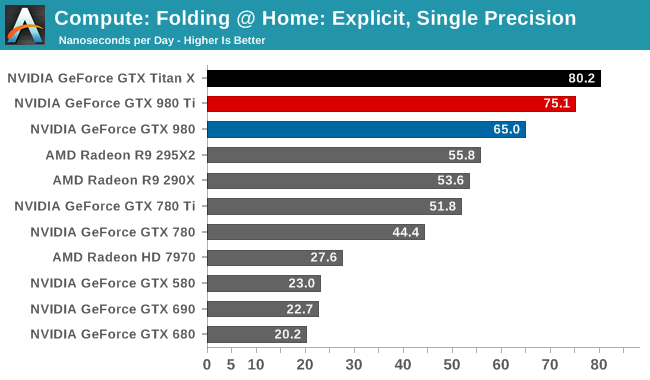
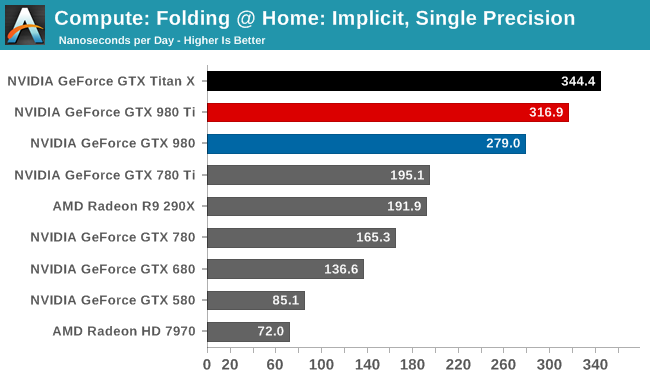
Folding @ Home’s single precision tests reiterate GM200's FP32 compute credentials. Second only to GTX Titan X, GTX 980 Ti fares very well here.
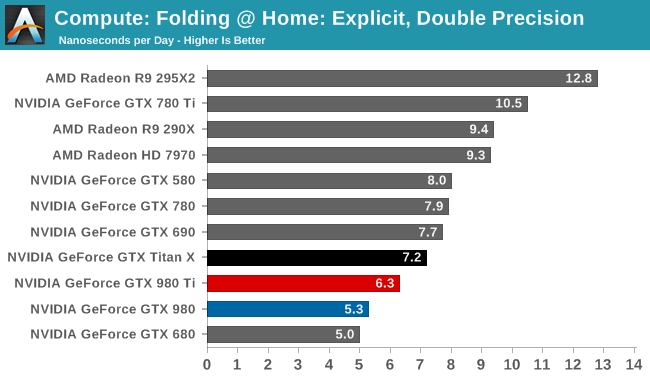
Meanwhile Folding @ Home’s double precision test reiterates GM200's poor FP64 compute performance. At 6.3ns/day, it, like the GTX Titan X, occupies the lower portion of our benchmark charts, below AMD's cards and NVIDIA's high-performnace FP64 cards.
Wrapping things up, our final compute benchmark is an in-house project developed by our very own Dr. Ian Cutress. SystemCompute is our first C++ AMP benchmark, utilizing Microsoft’s simple C++ extensions to allow the easy use of GPU computing in C++ programs. SystemCompute in turn is a collection of benchmarks for several different fundamental compute algorithms, with the final score represented in points. DirectCompute is the compute backend for C++ AMP on Windows, so this forms our other DirectCompute test.

We end up ending our benchmarks where we started: with the GTX 980 Ti slightly trailing the GTX Titan X, and with the two GM200 cards taking the top two spots overall. So as with GTX Titan X, GTX 980 Ti is a force to be reckoned with for FP32 compute, which for a pure consumer card should be a good match for consumer compute workloads.










290 Comments
View All Comments
Klimax - Tuesday, June 2, 2015 - link
@zepi: Perfect scaling on non-Intel's fabs doesn't exist as 16/14nm has 20nm metal layer and thus cannot scale as effectively.Refuge - Monday, June 1, 2015 - link
Distribution costs them more than manufacturing. lolChaser - Sunday, May 31, 2015 - link
That's pointless. 28nm with (Nvidia at least) is very energy efficient and as seen by this review a steal for the power this card delivers. It's a Titan X at $650.00. You're just desperately trying to find anything you can try and gripe about.Oxford Guy - Monday, June 1, 2015 - link
A GPU that expensive only qualifies as a steal if you're Leona Helmsley.mapesdhs - Tuesday, March 12, 2019 - link
2019 says hold my beer. :)Mark_gb - Monday, June 1, 2015 - link
Nvidia must make a living. No matter who they have to run over in the process. You, me, AMD... Doesn't matter. I imagine that at Nvidia, the mantra is "MUST MAKE MONEY! LOTS AND LOTS OF MONEY!", and that it repeats all day long, every day.P. T. Barnum was right... "There's a sucker born every minute."... and we are them.
Michael Bay - Tuesday, June 2, 2015 - link
What a shock that must be, for-profit corporation going about making profit. How dare they.mapesdhs - Wednesday, June 3, 2015 - link
Indeed, quite shocking. :)Personally I hope they make oodles of the stuff, so they can reinvest and make even better tech, because, my heavens, that's how private companies function. :D
It's weird how people complain about companies making profits, yet the very existence & continued success of a company depends on profits (unless of course one is AMD and somehow gets away with year after year of losses without going under).
(btw MB, please stop making crap Transformers movies... ;D Sorry, couldn't resist, hehe...)
FlushedBubblyJock - Wednesday, June 10, 2015 - link
the arabs have been shoring up amd - it's dirty oil money for the crime that amd isfingerbob69 - Tuesday, June 2, 2015 - link
Yeah ...but imagine how pissed you'd be if you'd brought a titan x in the last couple of months!I hope that extra 3% feels good!